|
|

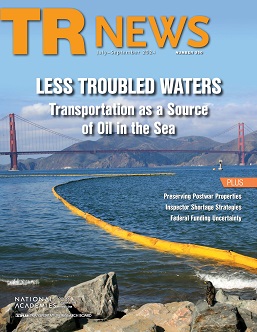 TR News 350
7/22/2024 7:23:00 PM
TR News 350
7/22/2024 7:23:00 PM
The July–September 2024 issue of TR News (Issue 350) features a look at the challenges presented by oil spills and the advances in oil spill science; guidance in evaluating the historic significance of post–World War II commercial properties; and the uncertainty of federal funding in state, local, and regional departments of transportation. The full issue is available online. TR News features timely articles on innovative and state-of-the-art research practice in all modes of transportation. It also...
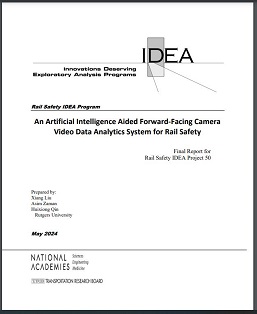 An Artificial Intelligence Aided Forward-Facing Camera Video Data Analytics System for Rail Safety
7/18/2024 2:00:35 PM
An Artificial Intelligence Aided Forward-Facing Camera Video Data Analytics System for Rail Safety
7/18/2024 2:00:35 PM
Trespassing along railroad rights-of-way continues to be the leading cause of rail-related fatalities in the U.S., demanding innovative solutions to gain deeper insight into trespassing behaviors. The TRB IDEA (Innovations Deserving Exploratory Analysis) Program's Rail Safety IDEA Final Report 50: An Artificial Intelligence Aided Forward-Facing Camera Video Data Analytics System for Rail Safety proposes a technology solution to improve the railroad industry’s ability to understand trespasser trends and t...
 GHG Emissions and Climate Change in Environmental Reviews
7/18/2024 4:00:13 AM
GHG Emissions and Climate Change in Environmental Reviews
7/18/2024 4:00:13 AM
Many state departments of transportation are seeking ways to improve the way they address greenhouse gas (GHG) emissions and climate change effects in environmental reviews. NCHRP WebResource 3: GHG Emissions and Climate Change in Environmental Reviews , from TRB's National Cooperative Highway Research Program, provides tools, methods, and resources to support the consideration of GHG emissions and climate change effects in transportation project environmental reviews; describes how programmatic environm...
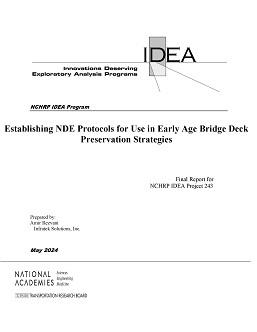 Establishing NDE Protocols for Use in Early Age Bridge Deck Preservation Strategies
7/11/2024 2:00:10 PM
Establishing NDE Protocols for Use in Early Age Bridge Deck Preservation Strategies
7/11/2024 2:00:10 PM
A bridge deck serves as the protective layer of the structure. However, the ingress of moisture and early age cracking in a steel-reinforced concrete bridge deck are often overlooked in their relationship to the overall trajectory of its deterioration. The TRB IDEA (Innovations Deserving Exploratory Analysis) Program's NCHRP IDEA Final Report for Project 243: Establishing NDE Protocols for Use in Early Age Bridge Deck Preservation Strategies presents a method to calculate a vulnerabilit...
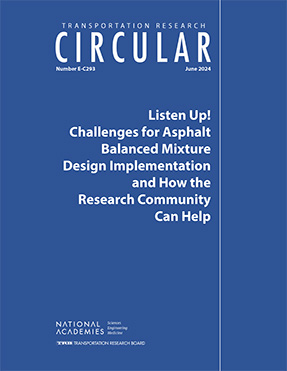 Listen Up! Challenges for Asphalt Balanced Mixture Design Implementation and How the Research Community Can Help
7/3/2024 3:30:24 PM
Listen Up! Challenges for Asphalt Balanced Mixture Design Implementation and How the Research Community Can Help
7/3/2024 3:30:24 PM
The design of asphalt mixtures for use in infrastructure applications has generated significant research and focus over recent years. Recent advancements in mechanical testing of asphalt mixtures, often referred to as "performance tests," brought to the asphalt community the concept of Balanced Mix Design (BMD) and the use of these tests to augment or go beyond volumetric design. TR Circular E-C293: Listen Up! Challenges for Asphalt Balanced Mixture Design Implementation and How the Research Community Ca...
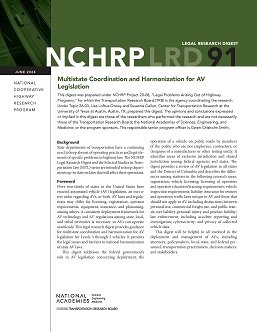 Multistate Coordination and Harmonization for AV Legislation
6/17/2024 12:00:26 PM
Multistate Coordination and Harmonization for AV Legislation
6/17/2024 12:00:26 PM
Over two-thirds of states in the U.S. have enacted automated vehicle (AV) legislation, an executive order regarding AVs, or both. AV laws and regulations may differ for licensing, registration, operator requirements, equipment, insurance, and platooning, among others. A consistent deployment framework for AV technology and AV regulations among state, local, and tribal territories is necessary so AVs can operate seamlessly. NCHRP Legal Research Digest 91: Multistate Coordination and Harmonization for AV L...
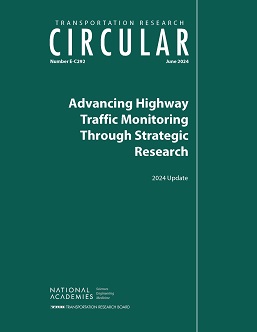 Advancing Highway Traffic Monitoring Through Strategic Research: 2024 Update
6/12/2024 2:00:55 PM
Advancing Highway Traffic Monitoring Through Strategic Research: 2024 Update
6/12/2024 2:00:55 PM
Monitoring travel on the nation's roadways is crucial for understanding the dynamics of the U.S. transportation system. This involves both broad assessments, such as calculating annual average daily traffic to report on vehicle miles traveled, and detailed analyses, like examining freeway operations on a minute-by-minute basis. TR Circular E-C292: Advancing Highway Traffic Monitoring Through Strategic Research: 2024 Update , from the Transportation Research Board, is a collaborative effort of over 60 spe...
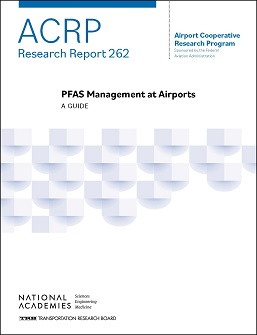 PFAS Management at Airports: A Guide
6/3/2024 2:00:57 PM
PFAS Management at Airports: A Guide
6/3/2024 2:00:57 PM
Per- and polyfluoroalkyl substances (PFAS) are found in many products, from consumer products to building materials. For airports, the primary implication is associated with aqueous film-forming foams (AFFFs) used in firefighting. For many years, airport operators were required to use AFFFs and, as a result of recommended training requirements and fire response, may have had releases of AFFFs to the environment. ACRP Research Report 262: PFAS Management at Airports: A Guide , from TRB's Airport Cooperati...
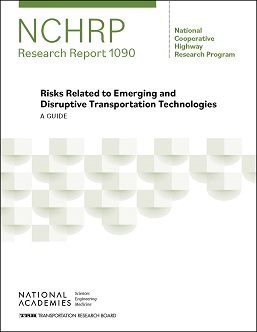 Risks Related to Emerging and Disruptive Transportation Technologies: A Guide
6/3/2024 2:00:00 PM
Risks Related to Emerging and Disruptive Transportation Technologies: A Guide
6/3/2024 2:00:00 PM
Emerging technologies present many potential challenges to state departments of transportation (DOTs) and other agencies that own and manage the existing infrastructure. Significant uncertainty exists about which changes are most likely to occur and where the largest impacts could be, hampering an effective national alignment in policy and approach. NCHRP Research Report 1090: Risks Related to Emerging and Disruptive Transportation Technologies: A Guide , from TRB's National Cooperative Highway Research ...
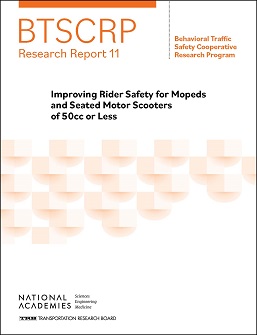 Improving Rider Safety for Mopeds and Seated Motor Scooters of 50cc or Less
5/30/2024 5:00:55 PM
Improving Rider Safety for Mopeds and Seated Motor Scooters of 50cc or Less
5/30/2024 5:00:55 PM
Relative to passenger cars, two- and three-wheeled vehicles such as motorcycles, mopeds, and seated motor scooters (50cc or less) are associated with a higher risk for fatalities and serious injuries in the event of a traffic crash, as they do not offer the protection of an enclosed vehicle or include other safety enhancement features such as occupant restraints. BTSCRP Research Report 11: Improving Rider Safety for Mopeds and Seated Motor Scooters of 50cc or Less , from TRB's Behavioral Traffic Safety C...
|
|